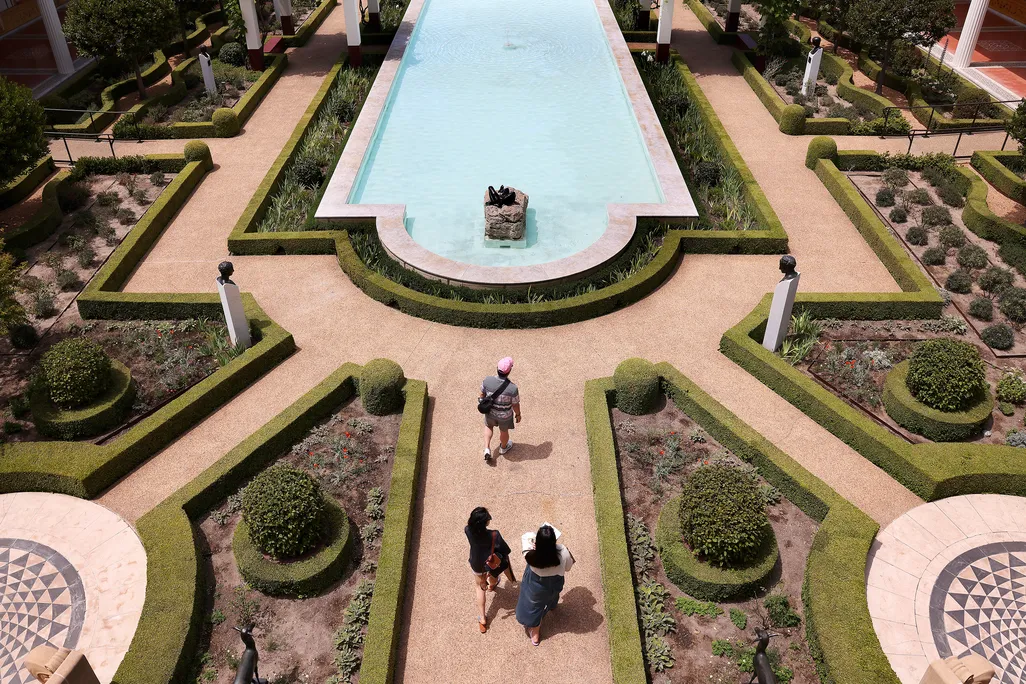The Getty Villa Reopens Six Months After the Devastating Palisades Fire
The iconic Los Angeles venue is welcoming visitors back with a new exhibition featuring artworks and artifacts from ancient Greece

When the Palisades fire swept through the Los Angeles area in January, flames came perilously close to the Getty Villa, the art museum founded by oil tycoon J. Paul Getty in 1974.
Fortunately, the building itself—and the massive collection of Classical and Renaissance works housed inside—was spared from damage. But the blaze did scorch the museum’s grounds, melting irrigation and security systems, burning more than 1,000 trees and blanketing the property in soot and ash.
Now, after a six-month closure, the Getty Villa has reopened to the public, reports Matt Stevens for the New York Times. On June 27, the iconic venue welcomed visitors back with its new “The Kingdom of Pylos: Warrior-Princes of Ancient Greece” exhibition, which includes more than 230 artifacts and artworks from Greece dating to the late Bronze Age. Many are being shown outside Europe for the first time, according to the museum.
Quick fact: What’s in the Getty Villa?
The museum in Los Angeles is home to 44,000 Greek, Roman and Etruscan antiquities.Crews worked tirelessly to clean up the damage on the 65-acre site, touching up soot-stained frescoes and filling the central reflecting pool with fresh, clear water. But they didn’t want to remove all traces of the blaze, which destroyed 6,800 structures and killed at least 12 people. So they left charred eucalyptus stumps in place and saved some singed Italian Cypress trunks. They’re also preparing fact sheets about the fire to share with visitors.
“We didn’t want to … erase the fact that this had happened,” says Katherine Fleming, president and chief executive of the J. Paul Getty Trust, to KABC-TV’s Carley Gomez. “It might have been the initial impulse to try and get everything back to the way it was as swiftly as possible. But we realized that it was really important, actually, that we leave some of the natural markers in our gardens that show that we have been through this fire.”
The museum’s leaders also thought carefully about the logistics of reopening, as they didn’t want to be insensitive or inconsiderate to their neighbors. For now, the Getty Villa is operating on a limited schedule (Friday through Monday from 10 a.m. to 5 p.m.) and requiring visitors to make timed-entry reservations. Only 500 guests are being admitted each day.
So far, residents and museumgoers seem happy to have the villa back open. “It symbolizes that everyone else who is affected will be able to get back to their lives as well,” says Heather Fuller, who visited the day it reopened, to the Christian Science Monitor’s Ali Martin.
Fleming adds that, as the difficult recovery and rebuilding process continues, she hopes the venue will provide “some respite and a place for people to reconnect with art and with each other,” she says in a statement.
When the fast-moving fire broke out on January 7, the Getty Villa activated its emergency response plan. Some staffers stayed on site to protect the building and the thousands of artworks, while others relocated roughly ten miles away to the Getty Center to coordinate the efforts, reported the Los Angeles Times’ Jessica Gelt at the time.
/https://tf-cmsv2-smithsonianmag-media.s3.amazonaws.com/filer_public/72/d8/72d8bcfc-5ebb-4f76-840c-39cf7ee7d7bc/gettyimages-2221644310.jpg)
The Getty Villa’s leaders had gone to great lengths to prepare for disasters like the Palisades fire, including regularly clearing brush and thinning trees around the building to reduce the amount of fuel for a wildfire. Many of the buildings on the property also feature fire-resistant design elements, including double walls around the galleries and the use of materials like steel and concrete.
Those efforts seemed to pay off. But the Palisades fire likely won’t be the last disaster the Getty Villa will face, so its leaders are also using this opportunity to reflect on what went well and what didn’t.
“If you can’t learn from what just happened, then you’re doomed to repeat it, or the situation could be worse,” says Les Borsay, an emergency preparedness specialist for the J. Paul Getty Trust, in the statement. “So we’re making sure that we look back at this and go, ‘Okay, what can we do better?’”
“The Kingdom of Pylos: Warrior-Princes of Ancient Greece” is on view at the Getty Villa in Los Angeles through January 12, 2026.
/https://tf-cmsv2-smithsonianmag-media.s3.amazonaws.com/accounts/headshot/SarahKuta.png)
